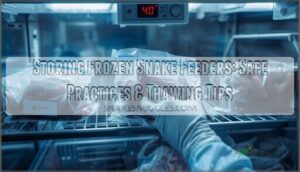This site is supported by our readers. We may earn a commission, at no cost to you, if you purchase through links.
 The snake diet one hour eating window compresses all your daily nutrition into just 60 minutes, followed by extreme fasting periods of 48-96 hours.
The snake diet one hour eating window compresses all your daily nutrition into just 60 minutes, followed by extreme fasting periods of 48-96 hours.
Created by Cole Robinson, this protocol mimics how snakes eat massive meals then fast for days. You’ll consume high-fat, low-carb foods during your brief window, aiming for ketosis through severe calorie restriction.
While proponents claim rapid weight loss, the approach carries significant risks including nutrient deficiencies, electrolyte imbalances, and potential organ damage.
The extreme nature makes it unsustainable for most people, with safer intermittent fasting alternatives like 16:8 offering similar benefits without the dangers. Understanding the specific phases and hidden pitfalls reveals why experts overwhelmingly recommend against this approach.
Table Of Contents
- Key Takeaways
- What is The Snake Diet One Hour Eating Window?
- How The One Hour Eating Window Works
- Foods Allowed During The Eating Window
- Potential Benefits and Claims
- Risks and Side Effects of Extreme Fasting
- Safer Alternatives and Expert Recommendations
- Frequently Asked Questions (FAQs)
- What is the eating window for the snake diet?
- What is the one hour eating window?
- Is the snake diet the same as intermittent fasting?
- Can you lose weight with a 10 hour eating window?
- Can I drink water during fasting periods on the Snake Diet?
- Can I exercise while following the Snake Diets eating window?
- Can I follow the Snake Diet if I have a medical condition, such as diabetes?
- Can diabetics safely follow this eating pattern?
- How does it affect athletic performance and recovery?
- What happens if you break the fast early?
- Conclusion
Key Takeaways
- You’ll consume all daily calories within just 1-2 hours, then fast for 22-96 hours, creating an extreme eating pattern that’s far more restrictive than standard intermittent fasting approaches.
- You’re likely to develop serious nutrient deficiencies and electrolyte imbalances since your body can’t absorb complete nutrition in such a compressed timeframe, leading to malnutrition risks and potential organ damage.
- You’ll face significant physical and mental health consequences including metabolic slowdown, dehydration effects, social isolation, and increased risk of developing eating disorders from the diet’s harsh restrictions.
- You can achieve safer, sustainable weight loss through moderate intermittent fasting like 16:8 or balanced calorie reduction, which offer similar benefits without the dangerous health risks of extreme fasting.
What is The Snake Diet One Hour Eating Window?
The Snake Diet’s one hour eating window restricts your daily food intake to just 60-120 minutes, following extreme fasting cycles that can last 48-96 hours between meals.
This approach mimics how snakes consume large meals then fast for extended periods, though it represents one of the most restrictive eating patterns in modern dieting.
Origins and Philosophy of The Snake Diet
The Snake Diet emerged from Cole Robinson, a self-proclaimed fasting coach without medical credentials.
His Diet History centers on mimicking Snake Metabolism—eating one large meal, then fasting extensively.
This Fasting Science approach promises rapid weight loss through extreme restriction.
Robinson’s Fasting Ethics involve pushing bodies "until you feel like death," creating controversy.
The snake diet plan gained traction through social media, with snake diet reviews showing mixed snake diet results and benefits claims lacking scientific support.
How The One Hour Window Fits In
How does this extreme eating window schedule actually work within the Snake Diet plan?
The 1 hour eating window represents the brief feeding period between extended fasting cycles, creating dramatic meal timing restrictions that promise rapid weight loss through severe calorie limitation.
The eating window schedule follows these key patterns:
- Phase 1: One meal after initial 48-hour fast, then return to extended fasting
- Phase 2: Single feeding opportunity every 48-96 hours during weight loss phase
- Phase 3: Maintenance involves eating once every 24-48 hours indefinitely
- Nutrient balance: Must pack all daily nutrition into extremely compressed timeframe
- Fasting benefits: Proponents claim ketosis and metabolic advantages from prolonged restriction
This snake diet plan creates eating patterns unlike traditional intermittent fasting approaches.
Why It’s Compared to Snake Eating Patterns
You’ll find this diet mimics snake behavior because serpents consume large prey then fast for weeks or months.
The snake diet benefits approach copies these natural eating cycles, where snakes gorge once and digest slowly, suggesting humans can follow similar metabolic patterns for weight loss.
This fasting method suggests humans can follow similar metabolic patterns for weight loss, though comparing human physiology to snake behavior lacks scientific backing for eating one hour a day protocols.
The snake diet’s restrictive nature is based on a fasting schedule concept that may not be suitable for all individuals.
How The One Hour Eating Window Works
The Snake Diet’s one-hour eating window creates an extreme pattern where you’ll fast for 22-23 hours daily, then consume all your calories within a single hour.
You’ll follow specific phases that cycle between extended fasts lasting 48-96 hours and brief feeding periods designed to maintain ketosis.
Typical Fasting and Feeding Cycles
The Snake Diet’s fasting patterns involve cycles of 48-96 hours without food, broken by single one-hour eating windows.
Unlike standard intermittent fasting approaches with 8-16 hour feeding windows, this extreme cycle length creates prolonged nutrient deprivation.
You’ll fast dramatically longer than typical 16:8 protocols, making hunger management challenging and nutrient timing nearly impossible to optimize properly.
The diet’s restrictive nature can lead to an unhealthy fasting routine, causing more harm than good.
Timing and Meal Structure
Your eating windows on the snake diet typically span just one hour, creating tight meal timing constraints.
During this brief window, you’ll consume your entire daily caloric intake in a single meal.
This one meal a day approach differs dramatically from traditional intermittent fasting schedules, which usually allow longer eating windows.
The compressed timeframe affects digestion patterns and nutrient balance, making proper meal planning essential for meeting nutritional needs within such restrictive parameters.
Example Day on The Snake Diet
A typical day looks like an endurance test wrapped in simplicity. You’ll wake up already fasting from the previous day, sip Snake Juice throughout the morning, and wait until your designated one hour eating window arrives.
Here’s what your snake diet for beginners schedule might include:
- Morning to afternoon: Fast while drinking Snake Juice for electrolytes
- One hour window: Consume your entire daily calories in low-carb, high-fat foods
- Evening: Resume fasting until the next day’s eating window
This 1 hour window diet pushes your body into ketosis quickly, but the extreme restriction raises serious diet safety concerns for most people. Understanding the ketosis induction process is vital to evaluating the effectiveness and risks of this diet.
Foods Allowed During The Eating Window
When you’re following the Snake Diet’s extreme one-hour eating window, you’ll need to pack all your daily calories into ketogenic-friendly foods that maintain the diet’s low-carb, high-fat approach.
The foods you choose during this brief window directly impact whether you’ll stay in ketosis and how well you’ll handle the upcoming 23-hour fast.
Recommended Macronutrient Ratios
During your one hour eating window, you’ll follow strict macronutrient balance guidelines that prioritize fat sources while restricting carb ratios.
Snake diet weight loss depends on achieving ketosis through extreme calorie deprivation, though this intermittent fasting approach risks serious nutrient deficiencies without careful nutrient timing and adequate protein intake.
Maintaining a low carb diet is essential for success in this type of fasting regimen.
| Macronutrient | Percentage of Total Calories |
|---|---|
| Fat | 70-85% |
| Protein | 15-20% |
| Carbohydrates | 5-10% |
| Daily Carb Limit | Under 20 grams |
| Protein Target | 1-1.2g per kg body weight |
Low-Carb, High-Fat Meal Ideas
Within your tight eating window, you’ll want keto recipes packed with healthy fats and minimal carbs.
Think avocado-topped salmon, grass-fed beef with butter, or eggs cooked in coconut oil.
These fat sources support ketosis while providing essential nutrients.
Smart meal planning guarantees macronutrient balance during your brief feeding period on this extreme intermittent fasting protocol.
Effective keto meal plans require consideration of keto diet rules to maintain a balanced diet.
Foods to Avoid
Several categories of foods can derail your snake diet progress.
Processed foods loaded with additives sabotage weight loss goals, while high carbs like refined grains kick you out of ketosis.
Sugary drinks and fried foods represent classic unhealthy eating habits that restrictive diets aim to eliminate.
During fasting for weight loss, these foods undermine your efforts and make the already challenging protocol even harder.
Understanding the importance of ketosis benefits is essential for a successful snake diet implementation.
Potential Benefits and Claims
Proponents of the Snake Diet claim you’ll experience rapid weight loss and enter ketosis faster through extreme fasting cycles.
However, these promised benefits come with significant health risks that far outweigh any potential advantages.
Rapid Weight Loss Promises
Cole Robinson promises you’ll drop 2 pounds daily on the snake diet through extreme intermittent fasting and prolonged fasting cycles.
These fast results sound tempting, but rapid weight loss at this rate exceeds safe guidelines and creates serious health risks.
The diet’s severe calorie restriction leads to nutrition deficits and potential complications that outweigh any quick fixes it offers.
The snake diet’s weight loss claims are based on principles of ketosis benefits that trigger autophagy for cellular cleanup, which is a key aspect of the diet’s proposed weight loss mechanism.
Metabolic and Ketosis Effects
The snake diet’s one-hour eating window triggers ketosis faster than traditional 16:8 intermittent fasting.
Your glucose levels drop substantially during 22-hour fasts, boosting insulin sensitivity. However, this metabolic state comes with trade-offs.
Extended fasting effects include potential metabolic rate slowdown due to adaptive thermogenesis. While ketosis benefits may include improved fat burning, your body might conserve energy after prolonged restriction.
The snake diet’s effectiveness is based on ketosis benefits.
Claimed Health Improvements
Proponents claim the Snake Diet delivers impressive health benefits beyond rapid weight loss.
You’ll hear promises of metabolic boost through extended fasting periods, with ketosis effects supposedly improving mental clarity and energy levels.
Snake diet transformation stories often highlight reduced inflammation, tighter skin, and even claims of reversing type 2 diabetes.
However, these fasting outcomes lack solid scientific backing, making such health benefits questionable at best, due to a lack of solid scientific backing and improving mental clarity.
Risks and Side Effects of Extreme Fasting
While the Snake Diet’s one-hour eating window might sound manageable, the extreme fasting periods can create serious health complications that you shouldn’t ignore.
The combination of severe calorie restriction and prolonged fasting puts your body under tremendous stress, potentially leading to nutrient deficiencies, electrolyte imbalances, and both physical and psychological harm.
Nutrient Deficiencies and Electrolyte Imbalances
While rapid weight loss might seem appealing, your body pays a steep price through severe nutrient deficiencies and dangerous electrolyte imbalances.
The snake diet’s promise of rapid results comes at a devastating cost to your health and wellbeing
The one-hour eating window creates nutrient gaps that lead to malnutrition risks, with studies showing up to 53.8% developing calcium deficiencies after extreme restriction. Your digestive system can’t absorb adequate nutrients during such compressed feeding periods, causing mineral deficits and dehydration effects from starvation-level intake.
- Electrolyte Balance disruption – Snake Juice electrolyte formula may oversupply sodium while creating potassium imbalances, risking dangerous heart rhythm changes
- Critical nutrient absorption failure – Your gut can’t process complete nutrition in one hour, leading to vitamin D, iron, and B12 deficiencies
- Rapid mineral depletion – Extended fasting accelerates calcium loss through urine, increasing osteoporosis risk while selenium and zinc levels plummet
Physical and Mental Health Concerns
Your body becomes a ticking time bomb when pushed to extremes.
The Snake Diet’s harsh restrictions trigger cascading health problems that extend far beyond simple hunger pangs.
| Physical Health Risks | Mental Health Concerns |
|---|---|
| Malnutrition risks from severe calorie restriction | Mental fatigue and cognitive impairment |
| Organ damage from prolonged nutrient deprivation | Eating disorders and obsessive food behaviors |
| Dehydration effects despite electrolyte supplementation | Anxiety and depression from food restriction |
| Electrolyte imbalances causing heart irregularities | Body dysmorphia and unhealthy self-perception |
| Metabolic slowdown making weight maintenance harder | Social isolation due to extreme dietary rules |
This unsustainable approach creates a perfect storm of nutritional deficiencies and psychological distress that can persist long after you’ve abandoned the diet.
Impact on Social and Emotional Wellbeing
Beyond physical symptoms, the snake diet’s extreme restrictions can fracture your social connections and emotional wellbeing.
You’ll likely skip family dinners, birthday celebrations, and work lunches—moments that build relationships through shared food rituals.
This social isolation often triggers emotional strains, affecting mental health and creating relationship issues.
The diet’s harsh messaging can worsen body image concerns, undermining emotional health when social connection matters most, leading to increased emotional strains and potentially severe relationship issues.
Safer Alternatives and Expert Recommendations
If you’re concerned about the Snake Diet’s extreme approach, you’ll be relieved to know that safer, evidence-based alternatives can help you achieve sustainable weight loss without the risks.
Expert-recommended methods focus on balanced nutrition and moderate calorie deficits rather than starvation-level restrictions, which can lead to sustainable weight loss.
Balanced Intermittent Fasting Approaches
Instead of diving headfirst into extreme fasting, consider gentler intermittent fasting approaches that won’t leave you feeling like a deflated balloon.
The popular 16:8 intermittent fasting method offers flexible fasting with an eight-hour eating window, allowing proper meal spacing and nutrient balance.
Time-restricted eating patterns like 14:10 or 12:12 provide healthy timing without extreme calorie control, making your fasting window manageable while maintaining a balanced diet.
Healthier Ways to Achieve Weight Loss
When you’re ready to step away from extreme restrictions, evidence-based approaches offer lasting results without compromising your health.
Sustainable eating patterns that include whole foods naturally reduce calories while preserving essential nutrients your body needs.
- 16:8 intermittent fasting provides structure without the snake diet’s extreme deprivation—eat within an 8-hour window daily
- Mindful nutrition focuses on hunger cues and food quality rather than arbitrary time restrictions
- Balanced lifestyle changes combine moderate calorie reduction (500-1000 daily) with regular physical activity for 1-2 pounds weekly weight loss
- Healthy habits like meal tracking, adequate sleep, and stress management support long-term success
- Holistic wellness addresses emotional eating patterns through behavioral modifications rather than punitive fasting
Understanding intermittent fasting benefits is essential for making informed decisions about your diet.
Time-restricted eating works best when it fits your lifestyle, not when it controls it completely.
Who Should Avoid The Snake Diet
Pregnant women, young adults under 18, and anyone with chronic illness shouldn’t attempt the snake diet due to severe health risks.
Those with mental health conditions or history of disordered eating face heightened malnutrition risks from this unsustainable weight loss approach, which can trigger dangerous eating patterns and worsen existing conditions.
Frequently Asked Questions (FAQs)
What is the eating window for the snake diet?
Ever wondered about extreme fasting schedules? The Snake Diet restricts you to just a 1-2 hour eating window daily, following prolonged 48-96 hour fasts with single meals between cycles.
What is the one hour eating window?
You get a one to two-hour window daily to eat after fasting for 22-24 hours. It’s extremely restrictive and poses serious health risks including nutrient deficiencies.
Is the snake diet the same as intermittent fasting?
The Snake Diet shares similarities with intermittent fasting but takes it to dangerous extremes.
While typical intermittent fasting uses moderate eating windows, you’ll face prolonged 48-96 hour fasts that risk serious health complications.
Can you lose weight with a 10 hour eating window?
Yes, you can lose weight with a 10-hour eating window. This moderate intermittent fasting approach naturally reduces calorie intake while remaining sustainable and safe for most people.
Can I drink water during fasting periods on the Snake Diet?
Water consumption during fasting is encouraged on the Snake Diet, including the promoted "Snake Juice" electrolyte drink.
However, this extreme fasting approach poses serious health risks including dehydration and nutrient deficiencies.
Can I exercise while following the Snake Diets eating window?
Exercise isn’t recommended during extreme fasting periods due to safety risks like dizziness, headaches, and fainting. Your body lacks adequate fuel, making workouts potentially dangerous and counterproductive for recovery.
Can I follow the Snake Diet if I have a medical condition, such as diabetes?
If you have diabetes, don’t attempt the Snake Diet—it’s extremely dangerous.
The prolonged fasting and severe calorie restriction can cause dangerous blood sugar swings.
Always consult your doctor before trying any restrictive diet.
Can diabetics safely follow this eating pattern?
No, diabetics shouldn’t follow this extreme eating pattern.
The Snake Diet’s prolonged fasting periods can cause dangerous blood sugar fluctuations, potentially leading to hypoglycemia or diabetic ketoacidosis.
You’d need medical supervision for any fasting approach.
How does it affect athletic performance and recovery?
Your athletic performance will likely plummet with this extreme fasting approach.
You’ll experience decreased energy, slower recovery, muscle loss, and impaired training capacity due to severe calorie restriction and nutrient deficiencies.
What happens if you break the fast early?
Like stepping off a treadmill mid-sprint, breaking your Snake Diet fast early disrupts the intended metabolic process.
You’ll likely exit ketosis, experience blood sugar fluctuations, and potentially trigger intense hunger that makes resuming fasting more difficult.
Conclusion
Like Pandora’s box, the snake diet one hour eating window releases consequences that can’t be easily contained.
While this extreme fasting approach promises rapid transformation, the evidence reveals significant health risks including nutrient deficiencies, electrolyte imbalances, and potential organ damage.
You’re better served by proven alternatives like 16:8 intermittent fasting, which offer sustainable weight management without compromising your wellbeing.
Remember, true health isn’t about extreme restrictions but balanced, consistent habits that support your body’s natural functions long-term.















